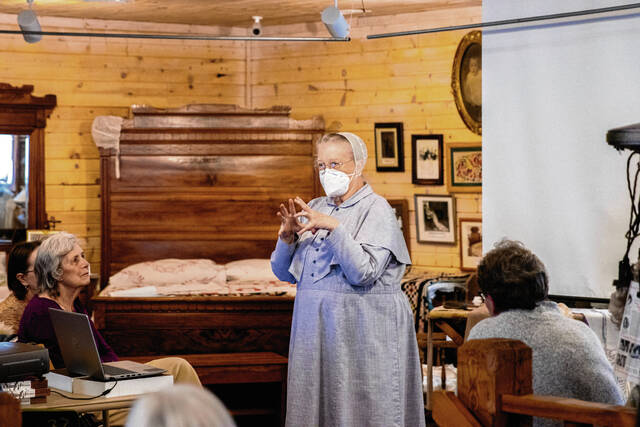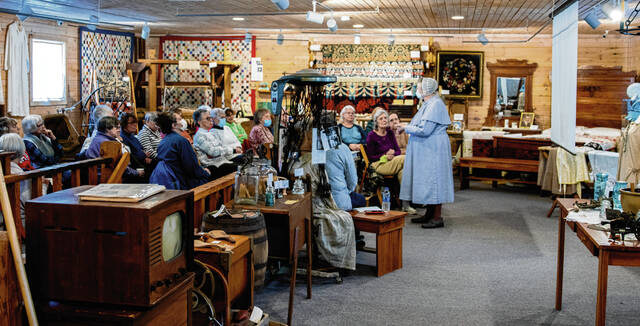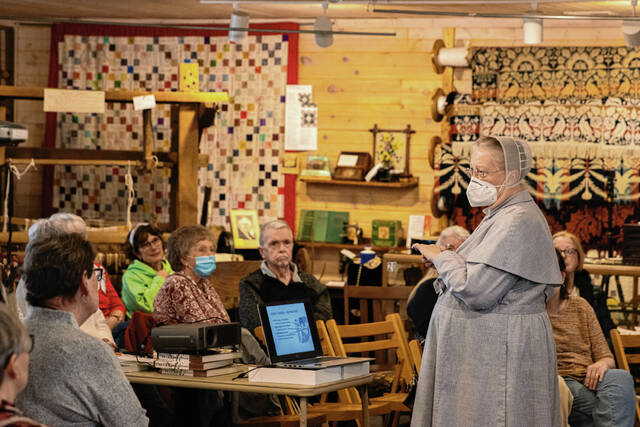
Lois Shuman, a member of the Old German Baptist Brethren church located near county roads 600 West and 400 South, speaks at Pendleton Historical Museum recently.
Kenny Humphrey | For The Times-Post

Lois Shuman, a member of the Old German Baptist Brethren church located near county roads 600 West and 400 South, speaks at Pendleton Historical Museum recently.
Kenny Humphrey | For The Times-Post

Lois Shuman, a member of the Old German Baptist Brethren church located near county roads 600 West and 400 South, speaks at Pendleton Historical Museum recently.
Kenny Humphrey | For The Times-Post
By Sue Hughes | For The Times-Post
PENDLETON — People in South Madison County might recall seeing members of Old German Baptist Brethren, clad in their distinctive traditional clothing, even if they aren’t much familiar with the Christian denomination.
Lois Shuman, 69 — who has been a member of the Old German Baptist Brethren, located at between Pendleton and Lapel, for more than 50 years — spoke at the Pendleton Museum on Feb. 26. She gave some history of the brethren and answered questions about their beliefs, such as why they dress like they do and and how their church services might differ from others in this area.
Addressing about 30 attendees, Shuman said the Christian religion was first organized in Germany in 1708.
The ruler of Germany at the time was tolerant to new religions, but when a later, less tolerant ruler took over, the German Baptists moved on to the Netherlands.
In 1719, the first members brought their religion to the United States. Like the followers of many other religions at the time, they settled in Pennsylvania, where William Penn had promised religious freedom, she said.
Old German Baptists are neither Catholic nor Protestant. They are recognized as Anabaptist.
Anabaptists establish rules that are to be strictly followed by the members of their sect, she said. Old German Baptists believe the newer sects are too progressive in their thinking.
The first group reached Pendleton in 1791.
“There are still descendants of the first families in our congregation today,” Shuman said.
Because the religious groups were so spread out in the state, one minister may have an area of 30 square miles to cover.
“It doesn’t sound like much now, said Shuman, but imagine how bad the roads were in the 1800s.”
About half of the Old German Baptists still live in Indiana and Ohio.
After Shuman’s talk there were many questions from the attendees.
She said her religion does not prohibit use of new technologies like some faiths. She has electricity, a microwave and many other modern comforts.
Shuman used a laptop during her presentation.
“We accept modern technology as long as it doesn’t get in the way of Christian living.”
She did point out that they do not have TVs, radios or the internet. She said “a computer without the internet is just a fancy typewriter.”
She uses her “fancy typewriter for her job with IU. While Shuman does have a phone, it is not a smart phone.
“I am able to text on my phone, but it’s a lot of work,” Shuman said with a laugh.
Church members do not vote or participate in government.
They are conscientious objectors and do not file or defend themselves in a lawsuit.
Children are encouraged to finish high school but for the most part are steered away from college, she said. They feel that college will cause children to question their beliefs.
Church services are different from what others might accustomed to seeing.
Meetings start with singing. There are no musical instruments.
“The minister reads the verse and the congregation sings it,” Shuman said.
There could be as many as five ministers for each service.
Ministers are appointed for life.
Normally, men and women sit on different sides of the church, but this is not a strict rule.
Old German Baptists have been called Dunkards and Tunkers. These names were used because they believe in full immersion baptism.
A person can become a member as soon as they reach the age of accountability, usually late teens or early 20s.
Children are encouraged to marry within the congregation.
Shuman said they have a 50% to 70% retention rate in their church.
Most women make their own clothes. Shuman said the cape is for modesty.
“When I became a member, I thought the dress was going to be very hot, but I got used to it, Shuman said.
Men wear plain coats and button-up shirts. Members of the ministry have a beard without a mustache. It is encouraged but not required among the membership.
Shuman finished her presentation by stating, “Everyone is welcome to visit our church.”